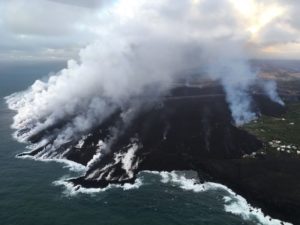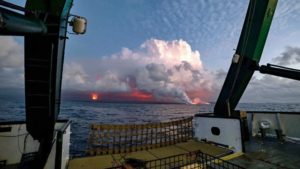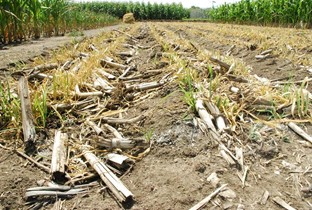Source: Wilson, S. T., N. J. Hawco, E. V. Ambrust, B. Barone, K. M. Bjorkman, A. K. Boysen, et al. (2019), Kīlauea lava fuels phytoplankton bloom in the North Pacific Ocean. Science, 365, 1040-1044. doi:10.1126/science.aax4767.
In summer of 2018, a large volcanic eruption in Hawai’i deposited tons of lava into the Pacific Ocean. While the injection of molten rock might have been expected to incinerate all marine life in the lava-impacted region of ocean, scientists mysteriously observed explosive growth of microalgae called phytoplankton.

Phytoplankton form the base of marine food webs and play an important role in the transfer of carbon dioxide (CO2) from the atmosphere to the ocean. They absorb CO2 from the atmosphere through photosynthesis, just like trees and other land plants. Therefore, predicting where phytoplankton will grow is important for modeling marine ecosystems and the global carbon cycle.
Satellite images are one of the main tools that scientists use to study phytoplankton blooms. This is because phytoplankton make the ocean appear greener, and these differences in the ocean’s color are visible all the way from space. When the Kīlauea volcano erupted in 2018, researchers at the University of Hawai’i saw from satellite images that there was a bloom in the region and reacted quickly by sending a ship out to collect data. Using these measurements, a recent study led by Samuel Wilson investigates why the lava deposition led to phytoplankton growth.

Phytoplankton blooms often occur when nutrient concentrations increase in the sunlit upper ocean. The data showed that the lava-impacted seawater had unexpectedly high concentrations of nitrate, which is an essential nutrient that supports phytoplankton growth. The lava itself contains almost no nitrogen, however, so the source of these nutrients couldn’t be from the lava itself. Where did the nitrate come from then?
In general, nitrate and other nutrient concentrations are high at great depths since organisms that need sunlight cannot grow there and thus the nutrients are not consumed. Scientists discovered that when the lava flowed into the ocean, it heated the nitrate-rich waters close to the seafloor. This caused the deep waters to become more buoyant and rise to the surface since the density of seawater decreases as its temperature increases. When this water upwelled, it brought nitrate to the upper ocean where it stimulated phytoplankton growth.
This study presents the first observational evidence of lava fueling a phytoplankton bloom. It is possible that this mechanism may have caused other ocean fertilization events off the Hawaiian Islands or in other coastal volcanic regions. Studies such as this, which examine the drivers of bloom location and timing, are important given the key role of phytoplankton in marine food webs and the global carbon cycle.
I’m a physical oceanography PhD student at Scripps Institution of Oceanography in La Jolla, California. I use a combination of numerical models, observations, and remote sensing to investigate the role of the ocean in climate. I’m particularly interested in Southern Ocean dynamics, including air-sea-ice interactions and physical controls on biogeochemistry.



